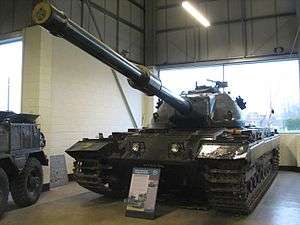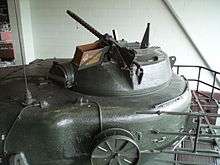Conqueror (tank)
The FV 214 Conqueror, also known as "Tank, Heavy No. 1, 120 mm Gun, Conqueror"[1] was a British heavy tank of the post-World War II era. It was developed as a response to the Soviet Joseph Stalin IS-3 heavy tanks; its 120 mm gun[2] was larger than the 20-pounder (83.8 mm) gun carried by its peer, the Centurion. The Conqueror's role was to provide long range anti-tank support for the Centurion. Conquerors were issued at nine for each regiment in Germany, usually grouped in three tank troops. In the British Army both the Conqueror and the Centurion were replaced by the Chieftain.
| FV 214 Conqueror | |
|---|---|
 Conqueror Mk I at The Tank Museum, Bovington (2008) | |
| Type | Heavy tank |
| Place of origin | United Kingdom |
| Service history | |
| In service | 1955–1966 (only in West Germany) |
| Production history | |
| Manufacturer | Royal Ordnance Factory, Dalmuir |
| No. built | 185 |
| Specifications | |
| Mass | 64 tonnes (71 short tons; 63 long tons) |
| Length | 38 feet (12 m) gun forward, 25 feet 4 inches (7.72 m) hull |
| Width | 13 feet 1 inch (3.99 m) |
| Height | 10 feet 5 inches (3.18 m) |
| Crew | 4 |
| Armour | 7 inches (180 mm), LOS 10 inches (250 mm) |
Main armament | L1 120 mm rifled gun |
Secondary armament | 2×7.62 mm machine guns |
| Engine | Rolls-Royce Meteor M120 810 hp (604 kW) |
| Power/weight | 12 hp/tonne |
| Suspension | Horstmann suspension |
Operational range | 161 km (100 mi) |
| Maximum speed | 35 km/h (22 mph) |
Design and development
The chassis was from the A 45 Infantry Support Tank, a project started in 1944 shortly after that of the A 41 Centurion. After the war, the project was relocated to that of the "Universal Tank" design of the FV 200 series. The 200 series was to have used a common hull for all uses (self-propelled artillery, armoured personnel carrier, three varieties of tank, etc.). One tank type was to be the heavy FV 201 of 55 tonnes, armed with an 83.8 mm gun.
In 1949, it was decided to bring the armament up to 120 mm. As this delayed the project, in 1952 the FV 201 hull was combined with a 17 pounder-armed Centurion Mk 2 turret to give the FV 221 Caernarvon Mark I.[3][4] Twenty-one were built with the Mk III 20 pounder turret as the Caernarvon Mk II. The FV 221 may originally have been intended to be the "Main Battle Tank" member of the FV 201 series but with the success of the A 41 Centurion such a vehicle was no longer required. In either event, the Caernarvon was only used for chassis development work serving in troop trials. In 1955, the first Conqueror was produced. Twenty Mark 1 and 165 Mark 2 Conquerors were built, including conversions of Caernarvon Mk IIs. Production continued until 1959.[2] It lost much tactical relevance once the Centurion was upgraded to an L7 105 mm gun.
The new, larger-calibre gun design was American, the same as used on the US M103 heavy tank;[5] with separate charge and projectile, as would also be the case in the Chieftain that followed. The charge was not bagged but in a brass cartridge, which offered some safety advantages, but reduced shell capacity to 35.[6]

The armour was very heavy for the time, especially in the front, where it was seven inches (178 mm) in the horizontal plane.[2] Unfortunately, this, along with the weight of the huge turret required to house the large gun and the very large hull volume, made the vehicle very heavy, giving it a relatively low top speed and making it mechanically unreliable. Also, few bridges could support its weight. However, rather like the Second World War Churchill tank, the Conqueror had exceptional terrain handling characteristics and proved to be as capable cross country as the lighter (and on paper slightly faster) Centurion tank.[7]
One feature of particular note was the rotating commander's cupola, which was at the heart of the Conqueror's fire control system and was advanced for its time. The commander could align the cupola on a target independently of the turret, measure the range with a coincidence rangefinder, and then direct the gunner on to the new lay mechanically indicated to him by the cupola. In theory, when the gunner traversed to the new lay, he would find the target already under his sights, ready to be engaged. Meanwhile, the commander was free to search for the next target. (The Soviet bloc also used similar devices, such as the TPKU-2 and TKN-3, on all of their post–World War II tanks, though theirs did not use a rangefinder.)
Variants

_Tank.jpg)
The variants of the Conqueror tank and developments directly related to its development are:
- FV 214 Conqueror
- Mk I (had three periscopes for the driver)
- Mk II (included better join of frontal armour plates, a single periscope for the driver, and an improved exhaust system)
- Mk II/I/H – rebuilt Caernarvons.[8]
- FV 215b
- Design study of Conqueror chassis with limited traverse turret mounting 183mm gun. Wooden mockup produced.[9]
- FV 221 Caernarvon
- Mk I – prototype
- Mk II – experimental series, 21 built
- FV 222 Conqueror Armoured Recovery Vehicle (ARV)
- Mk I – 8 produced
- Mk II[10] – 20 produced. Weight: 57 tons. Winch capacity: 45 tons (direct pull).
Operators

Surviving vehicles

In the United Kingdom, Conqueror tanks are displayed at The Tank Museum, Bovington,[11] at the Land Warfare Hall of the Imperial War Museum Duxford and at the Defence Capability Centre in Shrivenham. Other tanks are in the collections of the Musée des Blindés in France, the Gunfire museum in Brasschaat (a Mark 2) and the Kubinka Tank Museum, Russia. One is privately owned in the United States as part of the Littlefield Collection and another is in use as a gate guardian outside the Royal Tank Regiment Officers' Mess, which was restored by 2nd Royal Tank Regiment Light Aid Detachment (REME) in 2009, having previously been in a deteriorating state at Castlemartin Ranges (where it had previously been the guardian "Romulus" before being replaced by a German Leopard MBT).
There are also two MkII ARVs at the Military History Museum on the Isle of Wight in an unrestored condition. A MkII ARV is held by the REME Museum of Technology, although it is not on display.[12] There was formerly a Conqueror gate guardian at Base Vehicle Depot Ludgershall – informally known as "William". It is now part of the Isle of Wight Military Museum.
A Conqueror ARV remained in service at the Amphibious Experimental Establishment AXE, at Instow in North Devon, UK. It was used for beach tank recovery practice. At least one Conqueror exists in poor condition on the grounds of Kirkcudbright Training Area in Scotland, where it was used as a gunnery target. A number of Conquerors remain on the Haltern Training area in Germany.
References
- Notes
- No 2 for the Mark 2
- Ford, World's Great Tanks, p. 119
- "Huge Tank Developed by British May Be Most Powerful Ever." Popular Mechanics, April 1954, p. 132.
- Evans; McWilliams; Whitworth; Birch (2004). The Rolls Royce Meteor. Rolls-Royce Heritage Trust. p. 112. ISBN 1-872922-24-4.
- Dunstan, Centurion, p. 10
- Norman, pages 14 and 16.
- Griffin, Conqueror, p. 50
- "FV-214 Conqueror". Retrieved 13 March 2018.
- AFV Profile No. 38
- Baxter, Breakdown, p. 77
- "Museum accession record". Archived from the original on 2 January 2014. Retrieved 14 November 2019.
- "Conqueror Armoured Recovery Vehicle Mark 2". REME Museum of Technology. Archived from the original on 2 January 2014. Retrieved 15 March 2011.
- Bibliography
- Baxter, Brian S. (1989). Breakdown: A History of Recovery Vehicles in the British Army. HMSO, for REME Museum. ISBN 0-11-290456-4.
- Dunstan, Simon (2003). Centurion Universal Tank 1943-2003. Osprey Publishing (UK). ISBN 978-1-84176-387-3.
- Ford, Roger (1997). The World's Great Tanks from 1916 to the present day. Brown Packaging Books. ISBN 1-897884-29-X.
- Griffin, Rob (1999). Conqueror. Crowood Press. ISBN 1-86126-251-5.
Norman, Michael, AFV Profile No. 38 Conqueror Heavy Gun Tank, Profile Publications
External links
| Wikimedia Commons has media related to Conqueror tanks. |